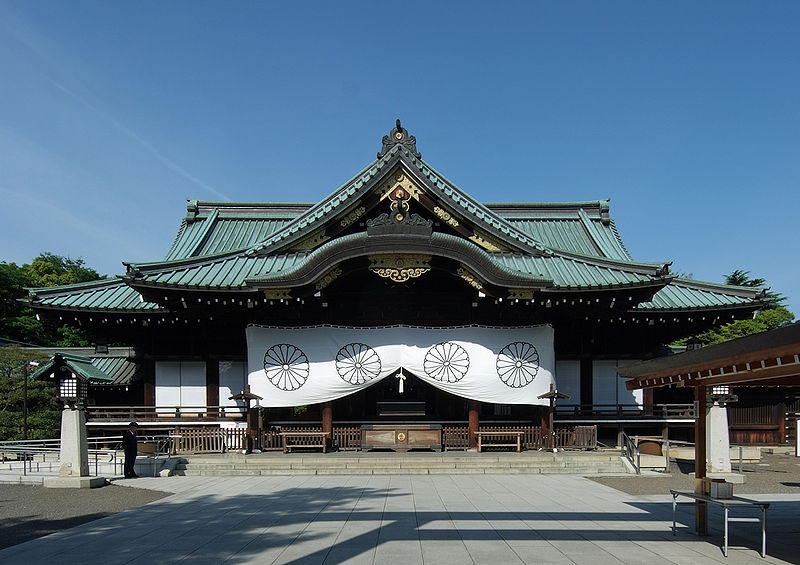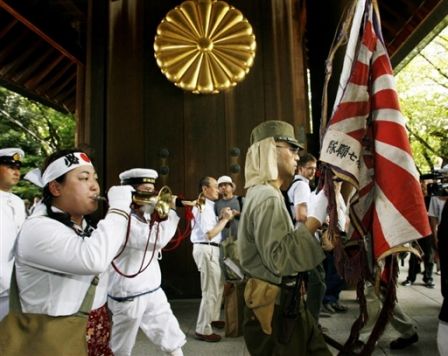Yasukuni Shrine in Tokyo remains a highly disputed space because of its symbolic role. This is seen most clearly in the adjacent museum, which takes a one-sided view of Japan’s role in WW2. The use of the shrine for nationalist ends has been highlighted in a popular manga by Kobayashi Yoshinori.
The popularity of the manga helps shed light on the bitterness of Korean and Chinese feelings towards Japan, for it claims in no uncertain terms that the Japanese Army did not invade Asian countries, but liberated them from colonial rule and goes on to assert that Nanking Massacre was a fabrication, that comfort women were volunteers, and that Japan was victimised by the West as exemplified by the war crime of Hiroshima.
The following paragraphs are extracted from ‘Revisioning a Japanese Spiritual Recovery through Manga’ in The Asia-Pacific Journal, Vol. 11, Issue 47, No. 2, November 25, 2013, by Mark Shields, Associate Professor of Comparative Humanities and Asian Thought at Bucknell University (Lewisburg, PA), and Japan Foundation Visiting Research Fellow at the International Research Center for Japanese Studies (Kyoto, Japan, 2013–14). (Please note that the headings are mine, not those of the original article.)
*************
What is State Shinto?
The basic “theology” of State Shinto, at least in its later, wartime incarnation, might be summarized as follows: (a) all Japanese belong to a single national body (kokutai), whose “head” is the emperor—not any specific person so much as the “unbroken” Yamato imperial line; (b) the Imperial House, by virtue of its lineal connection to the heavenly kami, as confirmed in the sacred classics, is sacrosanct and inviolable; (c) all Japanese, by virtue of being members of the national body, owe their complete allegiance and filial piety to the emperor, a living kami; (d) by extension, all Japanese must obey the directives of the (imperial) state, even to the point of giving their lives for the kokutai. This is also the theological foundation of Yasukuni Shrine—albeit with a greater emphasis on the glories of self-sacrifice and martyrdom.
Yasukuni background
The shrine that would become Yasukuni was founded in 1869, a year following the Meiji Restoration, as a place for “pacifying” the spirits of all those killed in wars fought for the “nation.” Originally known as Tokyo Shokonsha (literally, Tokyo shrine for the invocation of the dead), the name was changed to Yasukuni Jinja in 1879 at the behest of the Meiji Emperor. As Kobayashi notes, “Yasukuni” was chosen to imply “pacify the nation,” and in a (State) Shinto context this was understood to mean that the primary if not sole purpose of this shrine was to pacify the spirits of the war dead, which would help bring tranquility (and protection) to the national body (kokutai).
Administered directly by the ministries of the Army and Navy, by the time of the Russo-Japanese War (1904–1905), Yasukuni had entered into popular consciousness as a symbol of Japanese imperial conquest and a focus for the state-sponsored cult of the war dead. Today, Yasukuni enshrines the “souls” of 2.5 million people, including roughly 57,000 women, 21,000 Koreans, 28,000 Taiwanese, at least three Britons and, most controversially by far, 14 individuals indicted as “Class A” war criminals.
All of these men and women “offered their lives to the nation in the upheavals that brought forth the modern state” between 1853 and the present. As such, according to [manga writer] Kobayashi (and Yasukuni itself), those enshrined at Yasukuni are anything but “mere victims”. They are rather “martyrs” (junnansha), “heroic spirits” (eirei), and “(protective) gods of the nation” (gokokushin). As we shall see, the intertwined tropes of martyrdom and victimhood play an important role in the attempt to “restore” Yasukuni—and by extension, the true Japanese spirit and identity.
State Shinto and the Kokugaku roots
In contrast to the coverage of the various political issues raised by Yasukuni, the more specific religious or “theological” elements are often overlooked in popular coverage as well as within scholarly analysis. Yasukuni is, after all, a “shrine,” and one that has played a central role in the formulation and expression of a particular religious ideology that is known today as “State Shinto”.
While there remains much debate over the precise meaning of State Shinto, there is consensus that modern Shinto nationalism has roots in the so-called National Learning or Nativist School (kokugaku) of the mid- to late Edo period (1600–1867). While Motoori Norinaga (1730–1801) is the most significant early Figure in Shinto revivalism, it was his self-proclaimed successor, Hirata Atsutane (1776–1843), who transfigured nativist doctrine into a more “heroic” and populist form, focused on loyalty, patriotism and attunement to the spirits of the dead.
Continuing role of Yasukuni as a symbolic space
Although State Shinto was officially “disestablished” after the war, and has, along with ultra-nationalism and militarism, come to be repudiated by the vast majority of the Japanese people, the institutionalized form of Shinto as embodied in the postwar Association of Shinto Shrines (Jinja Honcho) contains more than a few hints of its more obviously politicized forerunner.
This is most clear in the promotion (and widely accepted notion) of Shinto as a cultural (if not “ethnic”) form that is somehow inherent to being “Japanese” (a belief that often goes hand-in-hand with a reluctance to label Shinto a “religion”). Indeed, Shinto-consciousness—or, since the word “Shinto” itself is not commonly employed in Japanese, kami, jinja, or matsuri-consciousness—plays a significant role in contemporary Japanese national identity, though only when reframed in terms that make it appear “cultural” rather than religious or political.
Explicitly anti-political and anti-religious, this “folkism” or ethno-nationalism (minzokushugi) as a general pattern of thought remains strong in contemporary Japan, and can be readily tapped into by those whose aims are in fact political.
********************



